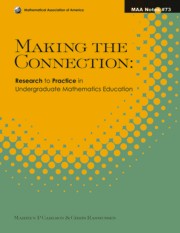Book contents
- Frontmatter
- Preface
- Contents
- Part 1 Student Thinking
- Part 2 Cross-Cutting Themes
- 2a Interacting with Students
- 13 Meeting New Teaching Challenges: Teaching Strategies that Mediate Between All Lecture and All Student Discovery
- 14 Examining Interaction Patterns in College-Level Mathematics Classes: A Case Study
- 15 Mathematics as a Constructive Activity: Exploiting Dimensions of Possible Variation
- 16 Supporting High Achievement in Introductory Mathematics Courses: What We Have Learned from 30 Years of the Emerging Scholars Program
- 2b Using Definitions, Examples and Technology
- 17 The Role of Mathematical Definitions in Mathematics and in Undergraduate Mathematics Courses
- 18 Computer-Based Technologies and Plausible Reasoning
- 19 Worked Examples and Concept Example Usage in Understanding Mathematical Concepts and Proofs
- 2c Knowledge, Assumptions, and Problem Solving Behaviors for Teaching
- 20 From Concept Images to Pedagogic Structure for a Mathematical Topic
- 21 Promoting Effective Mathematical Practices in Students: Insights from Problem Solving Research
- 22 When Students Don't Apply the Knowledge You Think They Have, Rethink Your Assumptions about Transfer
- 23 How Do Mathematicians Learn To Teach? Implications from Research on Teachers and Teaching for Graduate Student Professional Development
- About the Editors
20 - From Concept Images to Pedagogic Structure for a Mathematical Topic
from Part 2 - Cross-Cutting Themes
- Frontmatter
- Preface
- Contents
- Part 1 Student Thinking
- Part 2 Cross-Cutting Themes
- 2a Interacting with Students
- 13 Meeting New Teaching Challenges: Teaching Strategies that Mediate Between All Lecture and All Student Discovery
- 14 Examining Interaction Patterns in College-Level Mathematics Classes: A Case Study
- 15 Mathematics as a Constructive Activity: Exploiting Dimensions of Possible Variation
- 16 Supporting High Achievement in Introductory Mathematics Courses: What We Have Learned from 30 Years of the Emerging Scholars Program
- 2b Using Definitions, Examples and Technology
- 17 The Role of Mathematical Definitions in Mathematics and in Undergraduate Mathematics Courses
- 18 Computer-Based Technologies and Plausible Reasoning
- 19 Worked Examples and Concept Example Usage in Understanding Mathematical Concepts and Proofs
- 2c Knowledge, Assumptions, and Problem Solving Behaviors for Teaching
- 20 From Concept Images to Pedagogic Structure for a Mathematical Topic
- 21 Promoting Effective Mathematical Practices in Students: Insights from Problem Solving Research
- 22 When Students Don't Apply the Knowledge You Think They Have, Rethink Your Assumptions about Transfer
- 23 How Do Mathematicians Learn To Teach? Implications from Research on Teachers and Teaching for Graduate Student Professional Development
- About the Editors
Summary
The principal aim of this chapter is to provide a structure for mathematical topics as an aid to ‘psychologizing the subject matter’, as Dewey (1933) put it. The secondary aim is to reveal just how complex a matter preparing to teach a topic effectively can be, beyond trying to make the definitions and theorems as clear as possible.
The chapter develops the notion of a concept image (Tall & Vinner 1981) into a description of a framework based on a threefold structure of the psyche. Two mathematical topics, quotient groups and L'Hôpital's rule, are used to illustrate how the framework can be used as a reminder to direct attention to structurally different aspects of any topic when preparing to teach it. The framework can be used both at a more abstract level (for example, treating groups or limits as the topic) or at an even more detailed level (for example, quotient groups of cyclic groups or the relation between L'Hôpital's rule and derivatives). When combined with awareness of learners' mathematical powers and with ubiquitous mathematical themes and heuristics, the framework can be used to inform the design of pedagogically effective tasks and interactions with learners.
Concepts and Concept Image
Concepts are not isolated entities floating about in our minds but rather familiar ‘lines of thought’ triggered by concept labels.
- Type
- Chapter
- Information
- Making the ConnectionResearch and Teaching in Undergraduate Mathematics Education, pp. 255 - 274Publisher: Mathematical Association of AmericaPrint publication year: 2008
- 3
- Cited by



